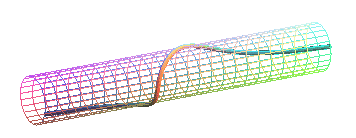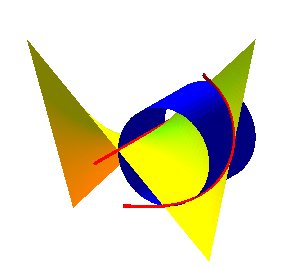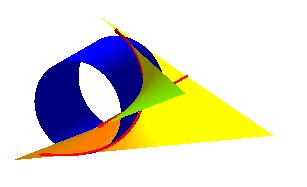HOROPTER CURVE

| next curve | previous curve | 2D curves | 3D curves | surfaces | fractals | polyhedra |
HOROPTER CURVE

| Curve studied by Helmholtz, Ludwig and Schur in 1902.
From the Greek horos "limit" and opter "observer". Other name: cubic circle. See on wikipedia a more general definition of this curve in the study of binocular vision. |
| System of Cartesian equations: Cartesian parametrization: Rational 3D cubic. |
| The horopter curve is the intersection between the cylinder
of revolution with axis x = a, z = 0 and passing by
O and the two rectangular hyperbolic
paraboloids with of equation We take out from this intersection the line Oy in the first case, and the line x= 2a, y=0 in the second case, this line being common to both the quadrics. The horopter curve is obviously also the intersection between the two aforementioned hyperbolic paraboloids. |
 |
 |
The Cartesian parametrization shows that the horopter curve is a cylindrical tangent wave; when the cylinder on which it is traced is developed, we get a tangentoid.
The projections on the planes xOy, xOz and
yOz
are the witch of Agnesi,
the circle
and the anguinea
,
respectively.
| next curve | previous curve | 2D curves | 3D curves | surfaces | fractals | polyhedra |
© Robert FERRÉOL 2018